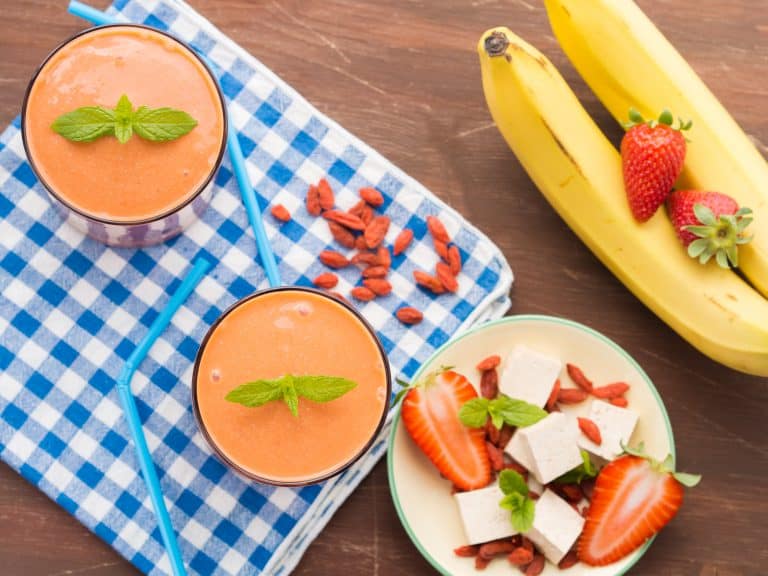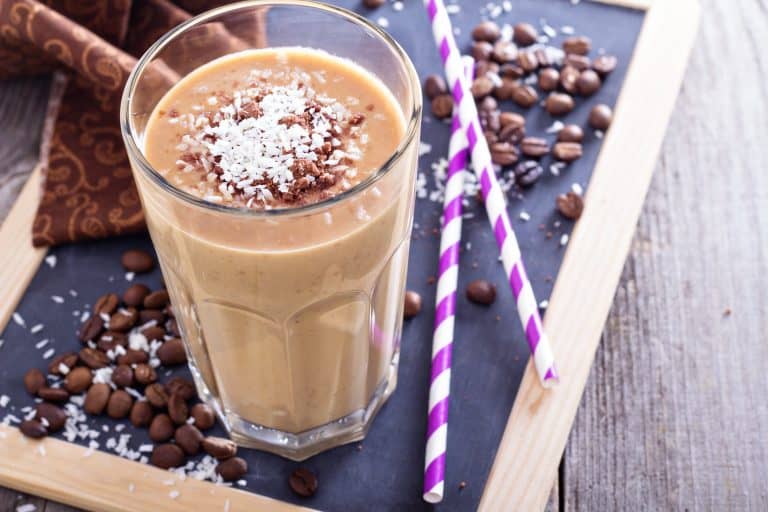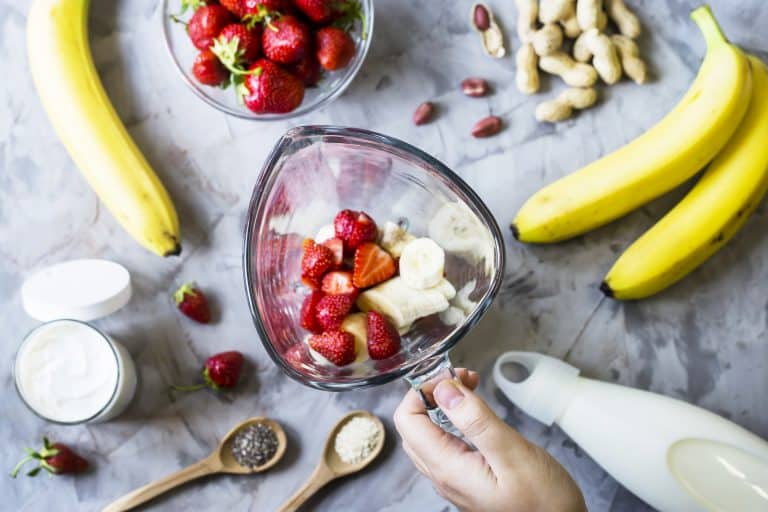Low Sugar Smoothies: Nutritious and Delicious Blends
Disclosure: This post may contain affiliate links, meaning I get a commission if you decide to make a purchase through my links, at no cost to you.
Smoothies have long been a go-to option for quick, healthy meals and snacks. However, with many smoothie recipes containing high sugar content, it’s important to find alternatives for those looking to reduce their sugar intake. This guide to low sugar smoothies has the answer.
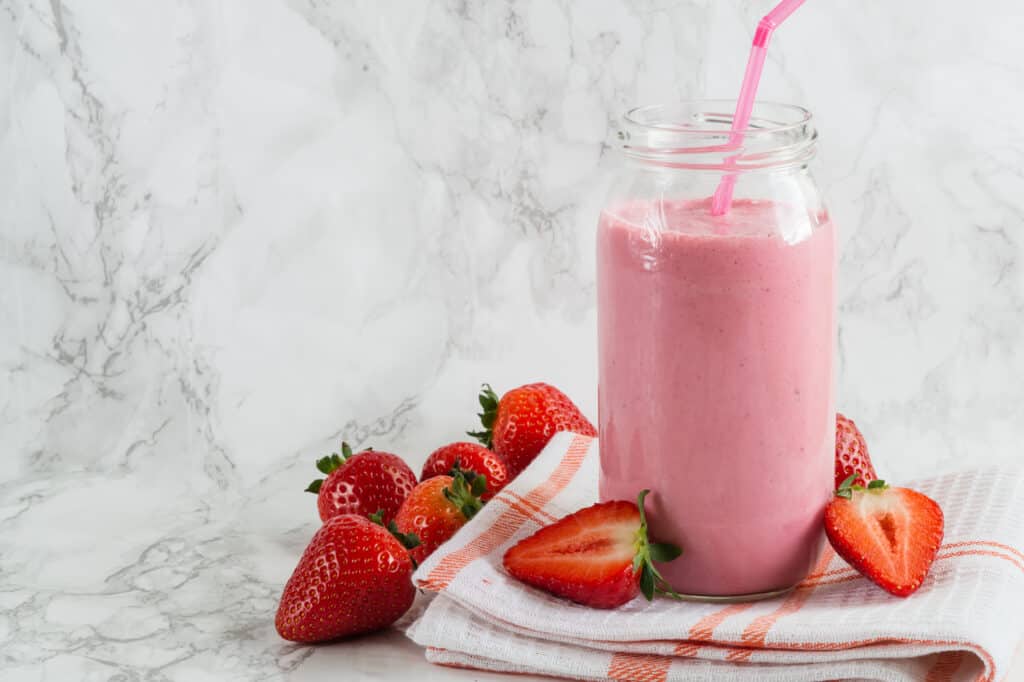
Find the recipe for this strawberry smoothie here… replace honey with stevia or monk fruit.
Low sugar smoothies provide a delicious and nutritious way for you to enjoy a refreshing treat without the worry of skyrocketing your sugar levels.
Incorporating dark leafy greens is a simple and effective way to create low-sugar smoothies. Greens, such as spinach, kale, collard greens, and Swiss chard, boast plenty of vitamins, minerals, and fiber without bringing excess sugar to the table.
By blending these with other whole ingredients, you can create a satisfying smoothie that nourishes your body while satisfying your taste buds.
Another key to crafting mouthwatering low sugar smoothies is to be mindful of the natural and added sugars inherent in fruits and other ingredients. By selecting fruits with lower sugar contents or strategically combining them with other low sugar components, your smoothies will maintain their health benefits without sacrificing taste or enjoyment.
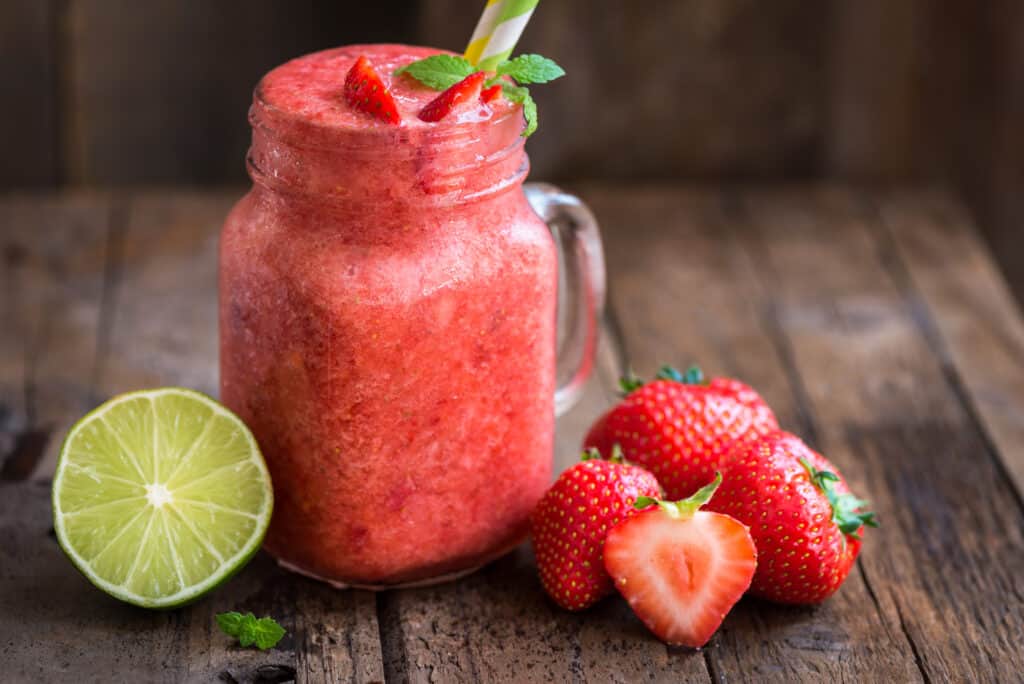
Understanding Low Sugar Smoothies
Natural Sugars vs Added Sugars
When it comes to low-sugar smoothies, it’s important to distinguish between natural sugars and added sugars. Natural sugars are found in fruits and vegetables, while added sugars are present in processed foods, such as fruit juices, sweeteners, and flavored yogurts.
In a low-sugar smoothie, you should focus on using fruits low in natural sugars and avoid adding any sources of sugar. By doing this, you’ll create a healthy and tasteful smoothie without overwhelming your blood sugar levels.
Blood Sugar Management
Managing your blood sugar is essential for overall health, particularly if you have diabetes or are at risk of developing it. Low-sugar smoothies help in this regard by minimizing the impact on your blood sugar levels.
To create a balanced smoothie, pair low sugar fruits like raspberries, strawberries, blackberries, or blueberries with dark leafy greens such as spinach, kale, collard greens, or Swiss chard, which are rich in vitamins, minerals, and fiber without adding excessive sugar.
Sugar Content in Fruits
When picking fruits for your low-sugar smoothie, pay attention to their sugar content. Here’s a list of fruits and their sugar content per 100g:
- Raspberries: 4.4g
- Strawberries: 4.9g
- Blackberries: 4.9g
- Blueberries: 9.9g
- Apples: 10g
Avoid fruits with higher sugar content like cherries, grapes, bananas and pears. It’s also best to steer clear of fruit juice, as juices can significantly increase the sugar content of your smoothie.
Importance of Healthy Fats
Incorporating healthy fats into your low-sugar smoothies can help minimize blood sugar spikes, increase satiety, and improve the overall nutrient profile. These fats can come from sources like nuts, seeds, avocado, or coconut milk.
For example, you can add a tablespoon of almond butter, chia seeds, or flaxseeds to your smoothie. Not only will this make your smoothie creamier and more satisfying, but it will also provide essential omega-3 fatty acids.
Remember, when making low-sugar smoothies, focus on the right balance of ingredients and always be mindful of their sugar content. With these tips, you’ll create healthy, delicious, and satisfying smoothies that won’t disrupt your blood sugar management goals.
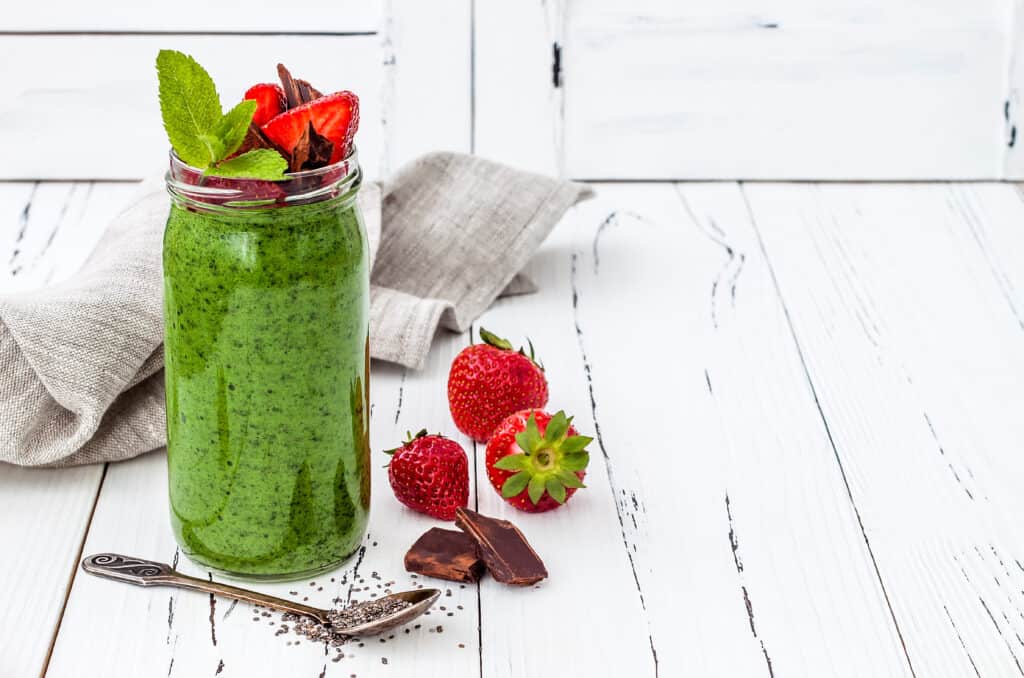
Tips for Making Low Sugar Smoothies
Choosing the Right Fruits
When making low sugar smoothies, it is essential to choose fruits that have a lower sugar content. Some good options include berries, kiwi, and green apples. These fruits not only provide a natural sweetness but also contain beneficial vitamins and minerals. Utilize fresh fruit over canned whenever possible, as canned fruit often contains added sugars and other preservatives.
Adding Protein and Nutrient Rich Ingredients
To make your low sugar smoothie more filling and nutritious, add protein and nutrient-rich ingredients. Some excellent options include:
- Chia seeds: These small seeds are packed with fiber, protein, and healthy fats, making them an excellent addition to any smoothie.
- Protein powder: Adding a scoop of your favorite protein powder can give your smoothie a significant protein boost. Opt for an unsweetened or low sugar version for the best results.
- Almond butter or peanut butter: These nut butters provide healthy fats and protein, adding creaminess and flavor to your smoothie. Choose unsweetened varieties for the lowest sugar content.
Additionally, consider incorporating unsweetened almond milk and coconut milk as your smoothie base. These plant-based milks offer a creamy texture without extra sugar.
Substituting Natural Sweeteners
To add a touch of sweetness without the sugar, consider using natural sweeteners such as:
- Stevia: A plant-based sweetener with zero calories and zero sugar content.
- Erythritol: A sugar alcohol that has minimal impact on blood sugar levels.
- Monk fruit: A natural sweetener with a low glycemic index, making it a good option for those watching their sugar intake. (This is my favorite option)
Remember to start with small amounts and adjust according to your personal taste preference.
Avoiding Fruit Juice
While fruit juices may be a common ingredient in many smoothies, they can drive up the sugar content quickly. Instead of using fruit juices, opt for fresh fruits or even water to help keep the sugar content in check. This way, you can still enjoy a tasty and refreshing smoothie without the concern of unnecessary added sugars.
By following these tips, you can create delicious and healthy low sugar smoothies that suit your taste buds and meet your nutritional needs. Enjoy experimenting with different combinations and finding your perfect low sugar smoothie formula.
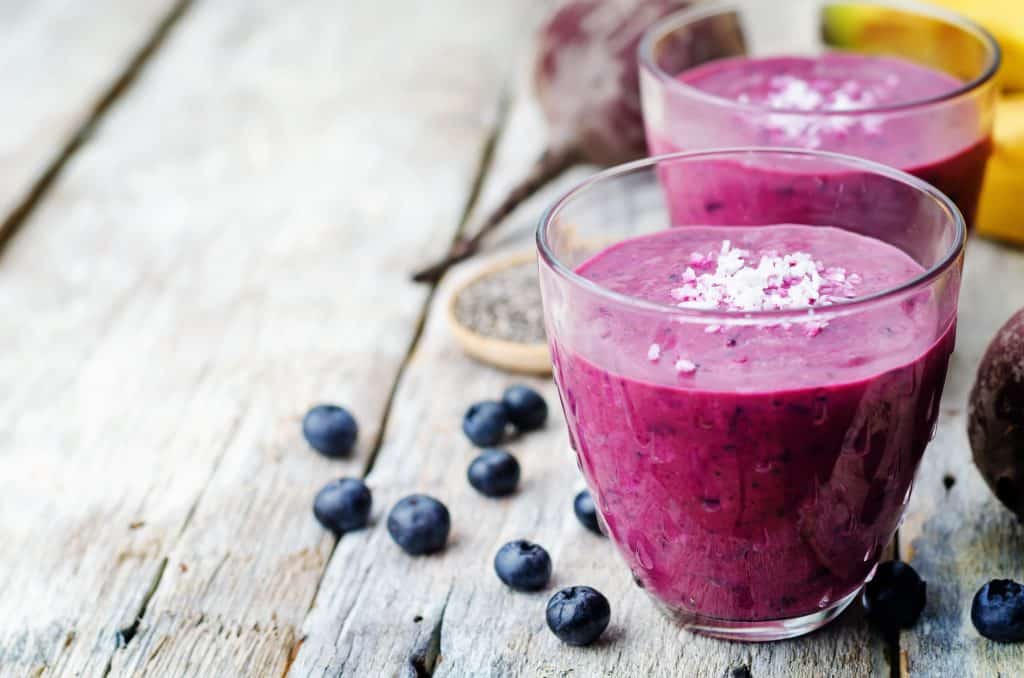
Healthy and Delicious Low Sugar Smoothie Recipe Ideas
Maintaining a balance between taste and health is essential when enjoying smoothies. Low-sugar smoothie recipes not only cater to your sweet tooth but also offer a great way of incorporating various nutritious ingredients.
Green Smoothies
Green smoothies are an excellent option for low-sugar recipes. Incorporating dark leafy greens adds vitamins, minerals, and fiber without much sugar. Some of the best options include:
- Spinach
- Kale
- Collard greens
- Swiss chard
Combine these greens with other low-sugar ingredients to create delicious and refreshing smoothies.
Protein-Packed Smoothies
Protein is a crucial component of a balanced diet, and it’s easy to add it to your low-sugar smoothies. Options include:
- Peanut butter or almond butter
- Nut-free options like sunflower seed butter
- Ground flax seeds, chia seeds, or hemp seeds
Adding protein not only increases the nutritional value of your smoothie but also helps keep you full and satisfied.
Fruit-Based Low Sugar Smoothies
Fruits can be low in sugar while still providing natural sweetness and flavor. Consider using these low-sugar fruits:
- Raspberries
- Strawberries
- Blackberries
- Blueberries
You can also incorporate frozen cauliflower to achieve extra nutrition and volume without impacting the taste.
Remember, you can experiment and mix various ingredients to find the perfect low-sugar smoothie for your taste buds. Keep your smoothies healthy, delicious, and low in calories by following these tips, and enjoy your guilt-free indulgence.

Expert Tips for Enhancing Smoothie Flavor and Texture
Benefits of Using Frozen Fruit
Using frozen fruit in your smoothies has several advantages. First, it’s a convenient way to make sure you always have fruits on hand without worrying about spoilage. Additionally, frozen fruits can add a thick, creamy texture to your smoothie, without the need for added sugar. Here are some fruits that work great frozen:
- Raspberries and blueberries: low in sugar and packed with antioxidants.
- Mango and pears: naturally sweet, adding a subtle flavor to your smoothie, but they do have a higher sugar content.
Adding Creaminess with Cottage Cheese and Greek Yogurt
For a creamy, protein-packed addition to your smoothie, consider using either cottage cheese or plain Greek yogurt. These ingredients not only provide a rich, velvety texture, but they also offer a significant nutritional boost:
- Cottage cheese: a high protein, low-fat option that contributes a creamy consistency to your smoothie.
- Plain Greek yogurt: a tangy option that contains probiotics, ideal for gut health.
Incorporating Cacao Nibs and Lime Juice
Adding cacao nibs and lime juice to your smoothies can give them a unique, invigorating twist:
- Cacao nibs: loaded with antioxidants and fiber, these tiny, crunchy bits provide a subtle, chocolatey flavor, without added sugar.
- Lime juice: lends a fresh, zesty taste and a boost of vitamin C to your smoothie.
Another bonus tip is to enhance your smoothie with a touch of vanilla extract. It can trick your taste buds into thinking they’re getting a sweet treat, even if the sugar content is low. By using these expert tips and experimenting with various ingredients, you can make low-sugar smoothies that not only taste great but are also good for you.
You can also use these tips to make low-sugar smoothie bowls!

The Role of Kitchen Equipment in Making Perfect Smoothies
Choosing the Right Blender
When striving to create a perfect low-sugar smoothie, it’s essential to start with the right blender. A high-speed blender is the ideal choice, as its power can efficiently pulverize fruits and vegetables, ensuring a smooth consistency. Look for a great blender with various speeds and settings to help you achieve the desired texture for your smoothie. The best part is that a quality blender can help you create that much-sought-after silky texture with minimal effort.
In addition to the blender’s motor power, pay attention to the blender container. For low-sugar smoothies, a container with built-in measuring lines or markers can be helpful in tracking ingredient quantities. This will assist you in creating a tasty and healthy drink without excessive sugar.
Proper Cleaning and Maintenance
A crucial aspect of making the perfect smoothie is ensuring that your blender and other kitchen equipment remain clean and well-maintained. Following a few practical steps can extend the life of your blender and make your smoothie preparation process seamless and enjoyable:
- Clean the blender promptly: Rinse and clean the blender container immediately after use. This helps prevent any residue buildup, which can affect the taste and quality of future smoothies.
- Disassemble for thorough cleaning: If your blender allows it, disassemble the container and blades for a more in-depth cleaning. This helps remove food particles that could be trapped in hard-to-reach areas.
- Dry the components: After washing, dry all parts of the blender, including the container and blades, to avoid potential bacterial growth from dampness.
- Inspect for wear and tear: Regularly check your blender for any signs of wear and tear, such as dull blades or a cracked container. Address these issues promptly to maintain your blender’s performance.
- Store properly: Store your blender in a cool, dry place when not in use.
By following these guidelines, you’ll be well on your way to crafting delicious and nutritious low-sugar smoothies with ease, thanks to the optimal performance of your kitchen equipment.
Common Questions about Low Sugar Smoothies
To reduce sugar in smoothies, use fresh fruits instead of sweetened or canned fruits, and avoid adding sugary drinks or syrups. Opt for water, unsweetened plant-based milk, or low-sugar yogurt as your base. Use a natural, low-glycemic sweetener like stevia, if needed.
The healthiest sweetener for smoothies isn’t sugar at all—it’s fresh fruits that are low in sugar, which naturally sweetens your drink. If you still need more sweetness, opt for a low-glycemic sweetener like stevia, monk fruit or erythritol. They provide sweetness without spiking your blood sugar levels.
Yes, sugar-free smoothies can be healthy if they’re balanced with nutrients. They should contain a variety of fruits, vegetables, healthy fats, and proteins. Remember, it’s not only about removing sugar, but also about what you’re replacing it with to maintain overall nutritional balance.
To sweeten a smoothie without sugar, use ripe fruits like bananas, peaches, or pineapples. They’re naturally sweet. You can also add spices like cinnamon or vanilla extract to enhance the sweet flavor. If you need more sweetness, consider adding a natural, low-glycemic sweetener like stevia.
Final Thoughts on Low Sugar Smoothies
Low sugar smoothies can be a delicious and nutritious addition to your daily routine. By carefully selecting and combining ingredients, you can create amazing-tasting fruit smoothies without the excessive sugar content.
Incorporating dark leafy greens, such as spinach, kale, collard greens, and Swiss chard, is a great way to add vitamins, minerals, and fiber to your smoothies while keeping the sugar content low. Make sure to balance the greens with low-sugar fruits, such as berries, to maintain a pleasant taste.
Remember to be cautious with high-sugar ingredients, such as bananas or dried fruits. If needed, you can add sweetness to your smoothie using natural sugar substitutes like stevia or monk fruit extract.
Another tip for creating low-sugar, healthy smoothies is to add protein and healthy fats to help keep you feeling fuller for longer. This can be achieved through ingredients like Greek yogurt, nuts, seeds, or protein powder.
Lastly, ensure your smoothies stay refreshing by using hydrating low-calorie liquid bases, such as water, unsweetened almond milk, or coconut water. This will also contribute to the overall low sugar content.
With these considerations in mind, you can confidently create your own low sugar smoothies that will not only taste fantastic but also support a healthy lifestyle. Just mix, blend, and enjoy!
Happy Blending!
Amanda
